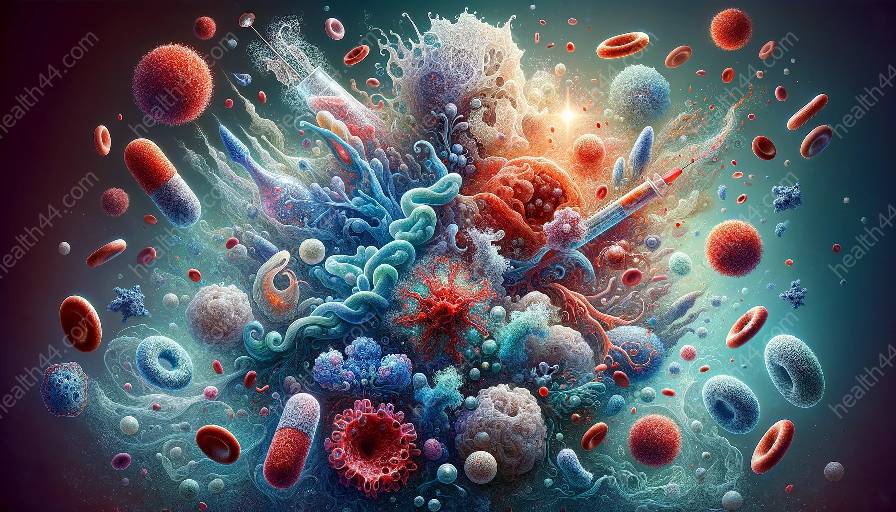Monoclonal antibodies, derived from immunoglobulins (Ig), play a significant role in therapy and research within the field of immunology. Understanding how these antibodies are utilized offers valuable insights into their impact on diverse medical conditions. From their inception to their current applications, this topic cluster will explore the fascinating world of monoclonal antibodies and their pivotal role in advancing medical science.
Understanding Immunoglobulins (Ig)
Before delving into the applications of monoclonal antibodies, it is essential to comprehend the foundation upon which they are built – immunoglobulins (Ig). Also known as antibodies, immunoglobulins are glycoprotein molecules produced by plasma cells that function as a critical component of the immune system.
Immunoglobulins are notable for their ability to recognize and bind to specific antigens, thereby facilitating targeted immune responses. These molecules consist of two identical heavy chains and two identical light chains, characterized by their variable and constant regions that contribute to their antigen-binding specificity.
Derivation of Monoclonal Antibodies from Immunoglobulins
Monoclonal antibodies, as the name suggests, are derived from a single clone of cells that produce identical antibody molecules. The process of generating monoclonal antibodies involves the fusion of a specific type of immune cell, known as a B lymphocyte, with a myeloma (cancer) cell to create a hybridoma cell line.
The hybridoma cell line possesses the ability to continuously produce a homogeneous population of antibodies that specifically target a particular antigen. Through this method, monoclonal antibodies can be engineered to recognize and bind to a wide array of targets, ranging from specific proteins to cancer cells.
Applications in Therapy
The therapeutic applications of monoclonal antibodies have revolutionized the treatment landscape for numerous medical conditions. Their ability to precisely target disease-related antigens while minimizing collateral damage to healthy tissues has paved the way for personalized and more effective treatment strategies.
One of the hallmark examples of monoclonal antibody therapy is the use of rituximab in the treatment of non-Hodgkin lymphoma and chronic lymphocytic leukemia. Rituximab specifically targets the CD20 antigen present on B cells, leading to their destruction and subsequent reduction of tumor burden.
In addition to their role in oncology, monoclonal antibodies have also been harnessed for the treatment of autoimmune disorders such as rheumatoid arthritis and psoriasis. Agents like adalimumab and infliximab, targeting tumor necrosis factor-alpha (TNF-α), have significantly improved the management of these conditions by modulating the inflammatory response.
Research Applications
Beyond therapeutic uses, monoclonal antibodies have become indispensable tools in the realm of research. Their high specificity and affinity make them invaluable for a wide range of applications, including diagnostics, imaging, and drug development.
In diagnostic settings, monoclonal antibodies are utilized to detect and quantify specific biomolecules, such as antigens or infectious agents, through techniques like enzyme-linked immunosorbent assays (ELISAs) and flow cytometry.
Moreover, the use of monoclonal antibodies in imaging technologies, such as positron emission tomography (PET) and single-photon emission computed tomography (SPECT), has enabled precise visualization of disease processes and the assessment of treatment response.
Impact on Immunology
The integration of monoclonal antibodies into the field of immunology has not only transformed therapeutic interventions and research methodologies but has also fostered a deeper understanding of immune responses and disease pathogenesis. By dissecting the molecular interactions between antibodies and their targets, scientists have gained crucial insights into the intricacies of the immune system.
Furthermore, the development of monoclonal antibodies has propelled the emergence of immunotherapies, wherein the body's immune system is harnessed to combat diseases like cancer. Immune checkpoint inhibitors, exemplified by pembrolizumab and nivolumab, have showcased remarkable success in unleashing anti-tumor immune responses.
Future Directions
As the field of immunology continues to evolve, the utilization of monoclonal antibodies is anticipated to expand even further. Ongoing research efforts are focused on enhancing antibody engineering techniques to improve their efficacy and minimize immunogenicity, thus broadening their applicability across diverse disease spectra.
Moreover, the exploration of novel targets and the development of bispecific and multispecific antibodies hold promise for addressing unmet medical needs and refining precision medicine approaches.
Conclusion
Monoclonal antibodies derived from immunoglobulins embody a remarkable convergence of scientific innovation and medical relevance. From their foundational origins in immunoglobulins to their widespread applications in therapy, research, and immunology, these antibodies continue to shape the landscape of modern medicine.
With their far-reaching impact on diverse medical conditions and their potential to drive groundbreaking advancements, monoclonal antibodies stand as a testament to the pivotal role of immunology in revolutionizing healthcare.


